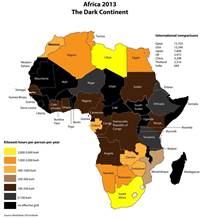|
 Three countries in Africa are reeling from the Ebola
crisis -- and nearly all African nations are challenged. In terms of electricity
it remains the Dark Continent. Africa has 49 countries, with a total
population of 1.1 billion. 70% of the people have no access to electricity. Three countries in Africa are reeling from the Ebola
crisis -- and nearly all African nations are challenged. In terms of electricity
it remains the Dark Continent. Africa has 49 countries, with a total
population of 1.1 billion. 70% of the people have no access to electricity.
Additionally, the generating
equipment, substations and grids of these countries are often in need of repair
or replacement, which means that available power is well below installed
capacity: in countries that have suffered civil war, such as the Democratic
Republic of Congo (DRC), only 48% of installed capacity finds its way to a plug
socket. (Global Construction Review)
In Sub-Saharan Africa, 80% of
families cook by burning wood or other biomass and lighting is by oil lamps. If
lucky, they have electricity from expensive diesel generators.
The recent International
Monetary Fund (IMF) Africa Energy Outlook report states "poor electricity
infrastructure is a key impediment to growth." Optimistically, the
IMF does project that 2 out of 3 investment dollars will produce energy in the
coming decades, with a target of achieving 2/3rds electrification on the
continent by 2040.
The world is rightly focused on west Africa's Ebola crisis, and it's clear from TV
images that lack of health care systems makes matters worse. Many clinics have
no consistent lighting, refrigeration or clean water. We know how to build
clean energy systems that "provide the cornerstone for poverty
reduction and economic growth." We can either avert our eyes – or
step up with money, expertise, training and compassion.
In Partnership for the Planet, |



